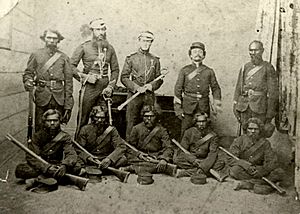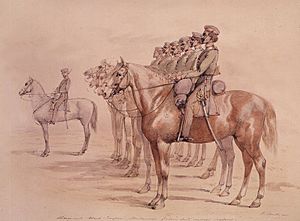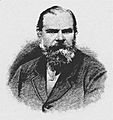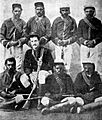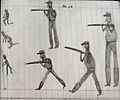Australian native police facts for kids
The Australian native police were special police groups in Australia. They were made up of Aboriginal troopers led by a white officer. These groups existed in different forms across all Australian colonies. They were active in the 1800s and, in some places, into the 1900s.
The Native Mounted Police rode horses because there were no cars back then. They patrolled very large areas. Their job was to bring law and order to places that had problems with crime. From their camps, they would ride out to investigate crimes, including suspected murders. They often carried rifles, carbines (shorter rifles), and swords. Sometimes, they also protected groups like surveyors, farmers, and gold prospectors in areas thought to be dangerous.
Aboriginal men in the Native Police were usually recruited from places far away from where they worked. This helped the colonists in a few ways. It kept police wages low and reduced the chance of Aboriginal people seeking revenge against white settlers. It also made the police force more effective. The Aboriginal troopers were amazing at tracking, which helped them find people in wild and difficult areas. Their skills in surviving in the bush were very important for the police.
The first police force funded by the government was the Native Police Corps. It started in 1837 in the Port Phillip District (which is now Victoria). From 1848, another force was set up in New South Wales. This group mostly worked in the area that later became Queensland. This force, sometimes called the "Native Mounted Police Force," was first paid for by large landowners. It became the biggest and longest-lasting native police force in mainland Australia. Some early units were known for being very quick to use their weapons. They were accused of shooting Aboriginal people, which was officially called "dispersal." This force existed from 1848 until about 1915, when the last Native Police camps in Queensland closed.
The "dispersal" of Aboriginal people also happened with native police in other colonies. Other groups, like farm workers, the colonial army, and the Border Police, also used this method. The government of South Australia created a Native Police force in 1852, but it didn't last long. It was started again in 1884 and sent to what is now the Northern Territory. The government of Western Australia also started a formal Native Police force in 1840. Other private native police groups were sometimes used too. For example, the Australian Agricultural Company had its own native constabulary in the 1830s. Native Police forces were also officially used in the Papua and New Guinea territories. These were managed by colonial Queensland and Australian governments from 1890 until the 1970s. The Australian government also had a native police force on Nauru from 1923 until 1968.
Contents
Early Ideas for Native Police
The idea for native police forces in Australia came from the sepoy and sowar armies of the East India Company. However, smaller forces like the Cape Regiment in southern Africa and the Kaffir and Malay Corps in Ceylon are a closer match. Before the first official Native Police forces, some unofficial and private groups used Aboriginal men. They helped European settlers enforce their land claims during colonization.
How the Native Police Started
In October 1837, Christian Ludolph Johannes de Villiers was chosen to lead the first official Native Police troopers. Their station was at Nerre Nerre Warren. There had been warnings against using native police. Some believed that "uncivilized men" fighting for order would "become the victims of their own zeal." The force was briefly shut down in January 1838. But it was restarted in April of the same year. Their new main base was in Jolimont, where the MCG carpark is today.
Due to money problems, the force was dissolved again in 1839. These issues delayed its return until Superintendent Charles La Trobe agreed to pay for it in 1842. A big reason for bringing the force back was a successful capture in 1840. Local Aboriginal men, working with Border Police and soldiers, captured five Tasmanian Aboriginal people near Westernport.
Henry EP Dana was chosen to lead the corps in 1842. For most of its time, the main base was at the Aboriginal Protectorate Station at Nerre Nerre Warren. This was near present-day Dandenong, about 25 km south-east of Melbourne. The force included Aboriginal men from the Wurundjeri and Bunurong tribes. It had 60 members, and three-quarters of them were Aboriginal.
There were two main goals for this force. One was to use the tracking skills of Indigenous people. The other was to help Aboriginal troopers fit into white society. Both La Trobe and William Thomas, who was a Protector of Aborigines, hoped the men would stop their traditional way of life. They thought the discipline of police work would change them. But the troopers still took part in corroborees (traditional ceremonies) and ritual fighting, even if not in uniform.
Wurundjeri elder, Billibellary, was very important for the success of the plan. After thinking about it, he supported the idea and even offered to join. He wore the uniform and enjoyed parading through the camp. But he was careful to avoid active police duties. He wanted to avoid a conflict between his role as a policeman and his duties as a Wurundjeri ngurungaeta (leader).
After about a year, Billibellary left the Native Police Corps. He found out it was being used to capture and kill other Aboriginal people. From then on, he tried his best to weaken the corps. As a result, many native troopers left, and few stayed longer than three or four years.
What the Native Police Did
The main job of the Native Police was to go to areas around the Port Phillip region. These were places where Aboriginal people were resisting European settlement. Settlers with weapons could not control this resistance. Once there, the troopers and their officers worked under the local Commissioner for Crown Lands. This commissioner would then try to find and capture or stop the resisting groups and individuals. Besides the Native Police, the Commissioner also had Border Police, NSW Mounted Police, and armed volunteer settlers. They all helped conduct raids against Aboriginal people.
Other smaller duties of the native police included searching for missing people. They also carried messages and escorted important visitors through unknown areas. During the goldrush era, they patrolled goldfields and looked for escaped prisoners. They were given uniforms, firearms, food, and a salary that was not always reliable. However, the excitement of the goldfields, low pay, and Dana's death in 1852 led to the official end of his Native Police Corps in January 1853.
During its time, this corps was active in three main areas: Portland Bay, Murray River, and Gippsland. Divisions of the Native Police would be sent to these areas each winter until 1852. They spent the rest of the year mostly at the Narre Narre Warren barracks. Winter was chosen for active duty because the Aboriginal people they targeted were more settled in colder periods. This made them easier to find.
Images for kids
-
Native Police with constables Bateman and Whiteford at Musgrave barracks around 1898
See also
- Aboriginal tracker
- First Nations Police (Ontario)
- History of Victoria
- History of Queensland
- List of massacres of Indigenous Australians
- United States Indian Police
- Victorian gold rush
- White Woman of Gippsland


